Leren hoe je varkens kunt fokken voor vlees is een geweldige optie voor elke woning of boerderij die meer zelfvoorzienend wil worden. Maar het kiezen van het ras en het afstemmen van de verzorging vergt wat knowhow. Lees verder voor 12 tips voor het fokken van varkens voor vlees.
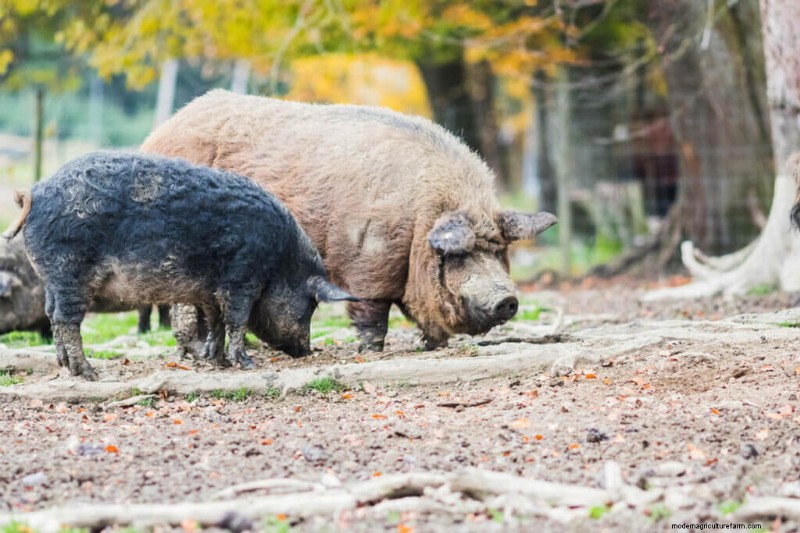
Dit bericht is oorspronkelijk geschreven en gepubliceerd in 2015 door Amy van Autumn Creek Ranch en is sindsdien bijgewerkt met mijn interview met "Pork" Rhyne Cureton voor nog meer informatie. Geniet ervan!
In eerdere podcasts heb ik besproken hoe ik Amerikaanse cavia's heb grootgebracht en waarom we voor dat specifieke ras hebben gekozen. En in een andere podcast besprak ik of we dachten dat de cavia's de moeite waard waren om te fokken voor vlees , inclusief of we ze al dan niet opnieuw zullen opvoeden.
De podcast-gast van vandaag (Pioneering Today Podcast aflevering #331) is "Pork" Rhyne en ik had het geluk hem te hebben ontmoet op de Homesteader's of America Conference . Ik kon niet wachten om hem op de podcast te krijgen om alles over varkens te bespreken!
"Pork" Rhyne werkt als internationale landbouwopleider en niche-vleesmarketingexpert. Hij heeft zijn leven gewijd aan het trainen en opleiden van ervaren en beginnende boeren op het gebied van zaken en marketing. (Lees onderaan dit bericht waar je Pork online kunt vinden!)
Als je nog niet klaar bent om je eigen vlees te fokken, namelijk varkensvlees, aangezien dat het onderwerp van de dag is, wil ik Butcher Box aanbevelen .
Butcher Box is toevallig een sponsor van de Pioneering Today Podcast en ze hebben nu tot en met 20 januari 2022 een speciale actie genaamd de nieuwjaarsbundel. In deze bundel, alleen voor nieuwe abonnees, krijg je 7 pond vlees GRATIS in je eerste doos! Ga naar butcherbox.com/pioneeringtoday aanmelden!
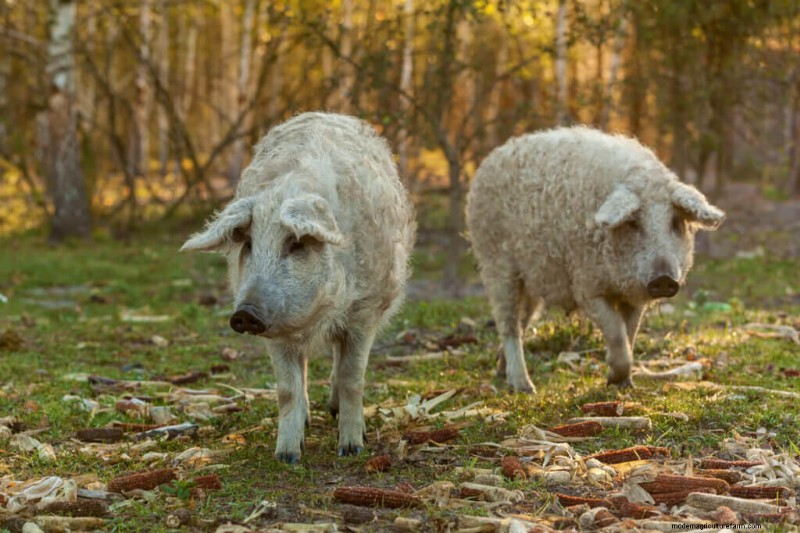
Ik denk echt dat varkens een van de gemakkelijkste dieren zijn om op een boerderij groot te brengen. Ze rijpen een stuk sneller dan een vleeskoe en geven veel meer vlees (en reuzel) dan een kip of konijn (en eerlijk gezegd pulled pork, vers spek,reuzel gemaakt in huis en gezouten hammen zijn gewoon geweldig!!!).
Voordat je begint met het fokken van varkens, lees voor meer informatie over het fokken van je eigen vlees dit bericht over het plannen van je vee en het fokken van genoeg vlees voor een jaar aan voedsel . Evenals het volgende voor andere dierspecifieke berichten:
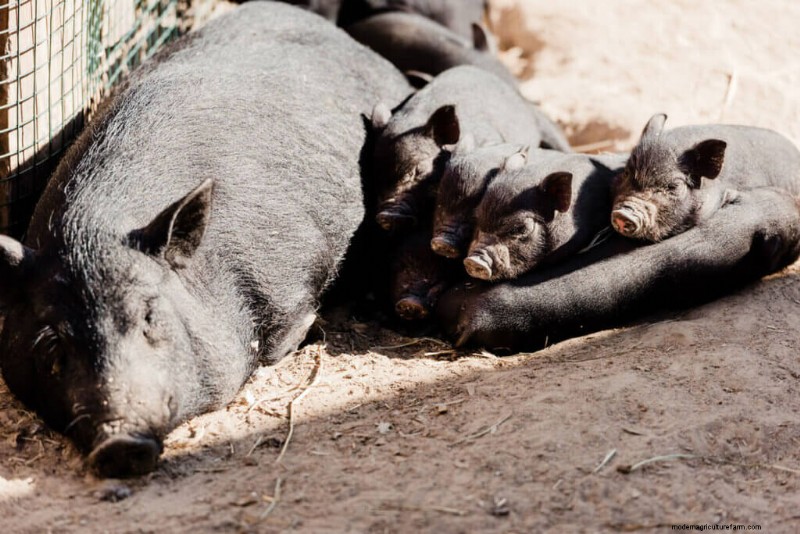
Dus misschien heb je erover nagedacht om een varken (of twee) te houden en weet je niet waar je moet beginnen? Hier zijn enkele tips en aanwijzingen die je hopelijk op weg helpen om je eigen heerlijke varkensvlees te kweken .
Voor iemand die geïnteresseerd is in slechts een paar varkens per jaar voor vlees, is het gemakkelijker om biggen te kopen dan om je eigen fokdieren groot te brengen.
Biggen variëren in prijs vanwege locatie, tijd van het jaar (ze zijn duurder in het voorjaar wanneer kinderen in 4-H ze proberen te vinden) en per ras.
Op het oorspronkelijke moment van het schrijven van dit bericht (2015) werden biggen verkocht voor ongeveer $ 125 per stuk, maar afhankelijk van de marktvraag konden ze al vanaf $ 75 worden gevonden. (Prijzen zijn nu waarschijnlijk hoger.)
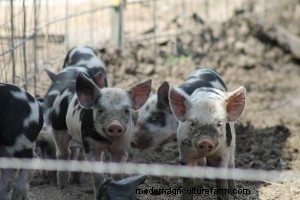
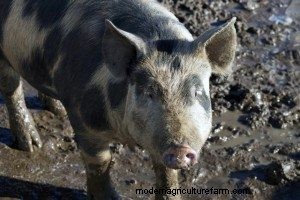
De industriestandaard voor de verkoop van babyvarkens is een leeftijd van 6 weken. We verkopen onze biggen echter als ze 8 weken oud zijn, omdat we merken dat biggen die die twee extra weken bij de zeug mogen blijven, een sterker immuunsysteem hebben en geen startvoer hoeven te krijgen.
Dat betekent natuurlijk dat we de zeug extra moeten voeren om haar conditie op peil te houden, maar we denken dat gezondere biggen het waard zijn.
Als u biggen kunt vinden die wat langer hebben mogen zogen, is het de extra kosten waard, omdat u hierdoor zowel op uw voerrekening als op mogelijke gezondheidsproblemen van de big kunt besparen.
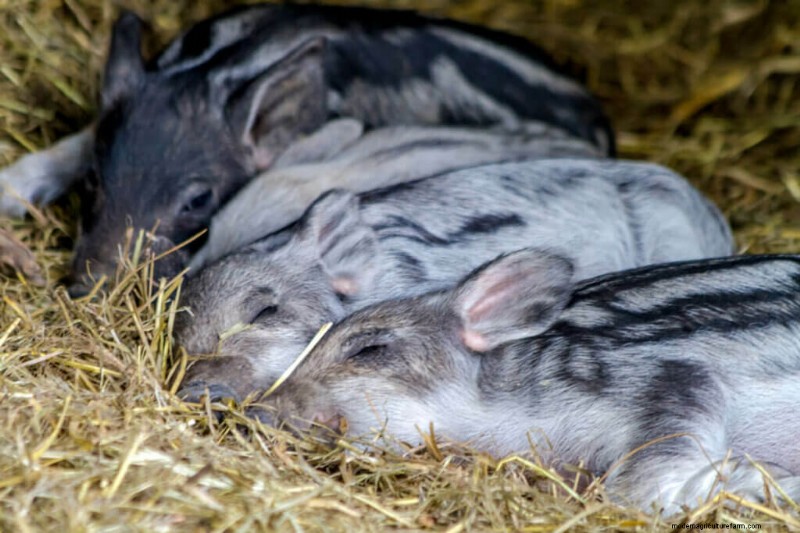
Voordat je biggen mee naar huis neemt, moet je een hok en een soort schuilplaats voor ze hebben. Ik zal zo dadelijk meer vertellen over schermen, maar er zijn enkele overwegingen waarmee u rekening moet houden bij het plannen van uw pen.
Als het hok klein is, groeien de biggen sneller omdat ze minder bewegingsruimte hebben en kan de grond echt kapot gaan.
Ook hebben parasieten in een kleiner gebied meer kans om te groeien. Ten slotte kan een klein hok in het voorjaar bij nat weer resulteren in een grote modderpoel.
Zoals Pork Rhyne in het podcast-interview bespreekt, betekent dit echter niet dat je ruimte moet hebben om je varkens te laten scharrelen of te laten grazen. Het fokken van je eigen varkens is een enorme stap vooruit ten opzichte van het kopen van commercieel gekweekte varkensvleesproducten, zelfs als je niet de ideale leefomstandigheden voor die varkens hebt.
We geven er de voorkeur aan om roterende gebieden te gebruiken in de warmere maanden en echt grote gebieden dichter bij het huis in de koudere maanden (we zetten eigenlijk varkens in onze tuingebieden tijdens de winter zodat ze ze kunnen bewerken en bemesten ter voorbereiding op het planten in de lente).
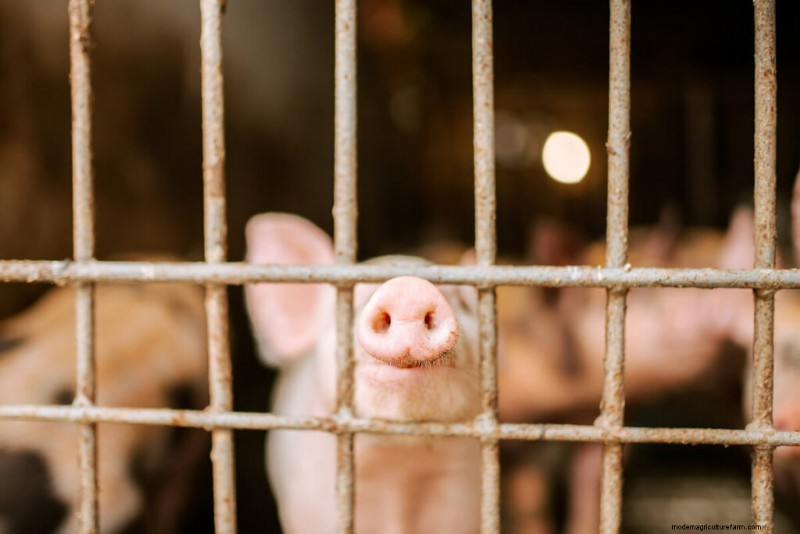
Als biggen jong zijn, kunnen ze beter in een rundveepanel, varkenspanel of pallethok staan.
Elektrisch gaas, touw of draad werken niet goed met kleine biggen omdat ze eruit kunnen (gesproken door veel ervaring en een big die twee weken lang in de omliggende bossen van ons erf is vertrokken).
We houden biggen tot ze ongeveer 12-15 weken oud zijn in een kleine veebox met elektrische draad op de bodem en daarna brengen we ze over in hokken gemaakt met elektrische draad of draad totdat ze het slachtgewicht bereiken.
Gewoonlijk zijn ze tegen 12-15 weken getraind voor het elektrische en zijn ze groot genoeg om er niet doorheen te rotzooien. Het is echter goed om een uitgang of poort te hebben die niet elektrisch is. Varkens kunnen zo goed worden afgericht dat schrikdraad afrastering is, dat als we ze willen verplaatsen, ze niet in de buurt komen van een plek waar vroeger schrikdraad stond.
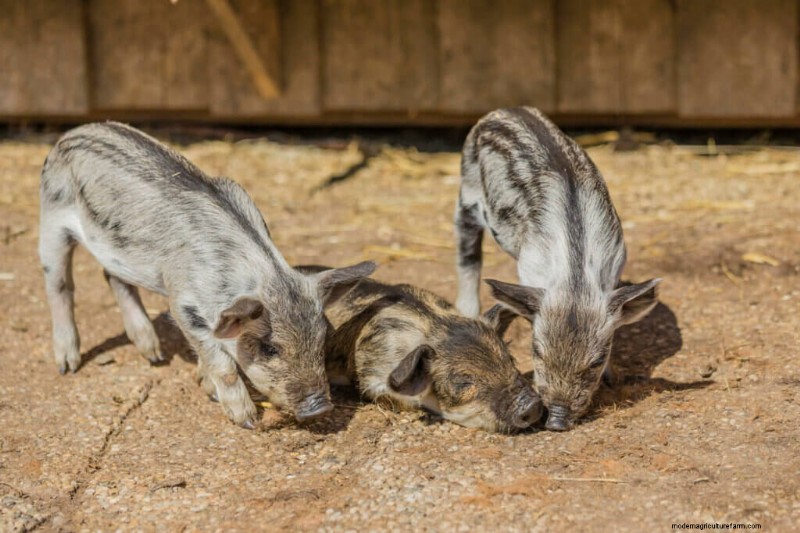
Er zijn veel manieren om je varken te voeren. Het gemakkelijkst is om een commerciële varkenskweker te kopen. Varkens groeien het snelst op dit type rantsoen. Helaas bevatten de meeste commerciële formules voor varkenskwekers maïs en soja, wat waarschijnlijk GMO is.
Veel commercieel voer bevat ook medicijnen die misschien niet nodig zijn voor uw specifieke dier.
Aangezien we onze dieren niet graag onnodig medicijnen geven, is een andere optie om je eigen voer te maken van een graan- en eiwitbron of een natuurlijk kant-en-klaar voer te zoeken bij jou in de buurt.
Dit is wat Pork Rhyne te zeggen heeft over het voeren van varkens… Er is zoveel controverse over wat je je varkens moet voeren, alles van naar je plaatselijke bakker gaan en varkens een dag oud brood voeren, tot alleen het beste, biologische, niet-GMO-voer kopen.
Er zijn zoveel mensen die net beginnen met het fokken van varkens die eigenlijk niet weten hoe een gezond varken eruit ziet. Daarom raadt hij aan om tijd door te brengen met iemand anders die varkens houdt om te leren en te wennen aan hoeveel varkens moeten eten, hoe hun eetlust varieert op basis van de seizoenen en hoe een gezond varken eruit ziet.
Wij homesteaders houden van de alternatieve route, elke keer dat we kunnen klussen of een alternatieve manier hebben om iets te doen, springen we erop! Ik denk dat het in onze aard zit. Maar voordat je begint met het maken van je eigen varkensvoer, is het belangrijk om de componenten van voer te begrijpen om te weten hoe je een varken moet voeren om een product te krijgen met een vet:vleesverhouding waarmee je tevreden bent als het tijd is om te slachten.
Als u eenmaal de basiscomponenten van het voer heeft, is het ook belangrijk om uw specifieke ras te kennen, omdat elk ras verschillende koolhydraat- en eiwitbehoeften heeft.
Als het om Amerikaanse cavia's gaat, zijn ze vatbaar voor obesitas, dus hebben ze een koolhydraatarm dieet nodig om te voorkomen dat de varkens te veel vet krijgen.
Varkensvlees Rhyne had een vriend die erg teleurgesteld was over de hoeveelheid vlees/vet-verhouding die hij kreeg na het slachten van zijn varkens, maar het bleek dat hij zijn varkens hun hele leven 16% ruw eiwit voerde in plaats van het eiwit te verminderen voorafgaand aan het slachten .
Doorgaans raadt Pork Rhyne aan om ongeveer 2-3 maanden voor het slachten de hoeveelheid eiwit te verminderen tot 12-14% en de hoeveelheid koolhydraten te verhogen om die energie in vet om te zetten.
Zoals ik hierboven al zei, varieert dit allemaal tussen rassen en is het verschillend voor herefords, erfgoedrassen, commerciële rassen, enz.
Naast kant-en-klaar voer zijn varkens dol op alle soorten producten. U kunt zelfs gewassen speciaal voor uw varkens laten groeien, zoals mangels, foerageerrapen, bieten en pompoen.
Op onze boerderij voeren we een combinatie van lokaal geproduceerde gerst en erwten met toegevoegde varkensmineralen. Onze varkens krijgen ook veel verse melk, tafelresten, lokale appels en pompoenen.
Voer uw varkens alstublieft geen bakkerijresten en dergelijke en verwacht een gezond varken met heerlijk smakend vlees. U eet wat uw varken eet, dus kwaliteit is belangrijk.
Een ander voorbeeld van manieren om varkens te voeren is dat Pork Rhyne een vriend heeft die naar Chipotle (de fastfoodrestaurantketen) is gegaan en bonen heeft opgehaald die niet aan consumenten zijn verkocht om zijn varkens te voeren.
Ik ben er helemaal voor om vindingrijk te zijn! Zorg er wel voor dat het voedsel dat u krijgt niet post-consumer is (wat betekent dat het niet eerst aan een klant is geserveerd en vervolgens in de prullenbak is gegooid omdat dat ziekten naar uw varkens zal verspreiden) en zorg ervoor dat er geen varkensvlees in het product zit.
Een ding dat ik graag doe, is mijn voer zo lokaal mogelijk inkopen. We hebben een graanschuur die ongeveer een uur verderop ligt en die een non-GMO-standpunt heeft en ook probeert hun graan zo lokaal mogelijk te betrekken. Voor geldbesparende tips over aankopen bij uw lokale graanschuur, ga naar Dierenvoer inslaan (+ Hoeveel dieren te voeren).
Weet ook dat als je je varkens bierbostel voert (zoals brouwersgraan dat je misschien van een brouwerij krijgt), ongeveer 80% daarvan water is. Als dat graan bijvoorbeeld droog was, zou het ongeveer 29% eiwit bevatten, terwijl als het graan eenmaal nat (of uitgeput) is, het slechts 7,7% ruw eiwit bevat.
Besteed graan beschimmeld ook heel snel, dus Pork Rhyne beveelt dit aan als aanvulling op een dieet, niet als primaire bron.
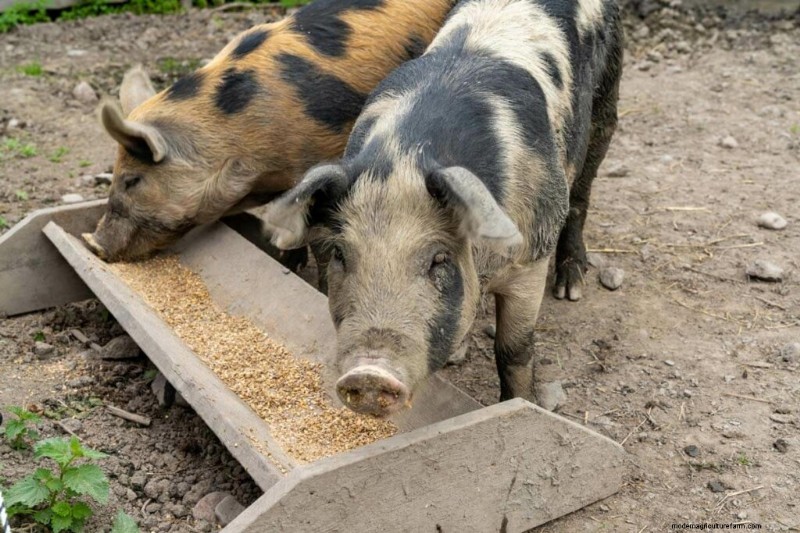
Een ander ding om te overwegen bij het fokken van varkens is of je een zelfvoeder moet opzetten en de varkens moet laten eten wanneer ze maar willen of dat ze elke dag een vaste hoeveelheid moeten voeren.
Voor beide zijn er voor- en nadelen. Gevraagd voeren maakt de dagelijkse werklast kleiner, behalve op de dag dat u de varkensvoerbak moet vullen. Als varkens altijd voer beschikbaar hebben, zullen ze ook minder snel wroeten en blijft je grond beter in vorm. Varkens die op vraag worden gevoerd, hebben ook de neiging sneller te groeien, dus uw tijd tot volwassenheid is korter.
Het probleem met vraagvoeding is dat varkens VEEL voedsel kunnen eten en dat dit duur kan worden, vooral naarmate de varkens ouder worden.
We hebben ontdekt dat als u slechts één of twee varkens grootbrengt, voer de juiste keuze is. Wanneer u 10 of meer verhoogt, kan het onbetaalbaar worden.
We geven elk van onze biggen elke dag 5 lbs van hun graanmengsel. Daarnaast krijgen ze melk, tafelresten en producten.
Dit stelt ons in staat om varkens van ongeveer 8 maanden op marktgewicht te hebben.
Ik ben geen fan van chemische ontwormingsmiddelen vanwege de mutaties en resistenties die ze creëren.
Op onze boerderij hebben we ontdekt dat knoflook sowieso een veel effectiever ontwormingsmiddel is.
We voegen ongeveer 1 pond knoflookkorrels toe aan een ton voer.
Bovendien is oregano-olie ook uitstekend in het bestrijden van parasieten en infecties.
Ten slotte houden we etherische olie van geranium bij de hand voor bloedingen (varkens kunnen in gevechten terechtkomen) en theeboomolie voor snij- en schaafwonden.
Het castreren van varkens is een controversieel onderwerp. Velen vinden de praktijk wreed en onnodig, maar anderen vinden dat het nodig is om berengeur te voorkomen.
Als u twee mannelijke varkens grootbrengt, moet u bepalen of u deze procedure wilt laten uitvoeren.
Wanneer je echter biggen van het andere geslacht grootbrengt, is het verstandig om door te gaan met castreren. Toen we begonnen met het fokken van biggen, werd ons verteld dat ze pas zouden beginnen met fokken als ze 9 maanden oud waren. Aangezien we met 8 maanden slachten, dachten we niet dat we moesten castreren.
Slecht advies en we kwamen uit bij drachtige marktvarkens. We castreren nu alle mannelijke biggen die voor vlees worden grootgebracht. We hebben Bach's Rescue Remedy gevonden zeer nuttig in het proces – het houdt zowel de varkens als de persoon die castreert kalm.
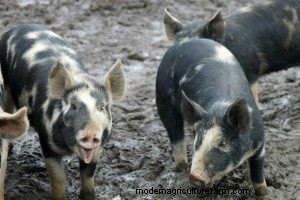
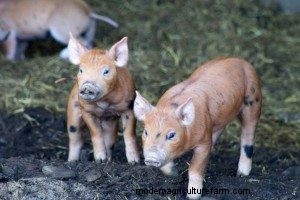
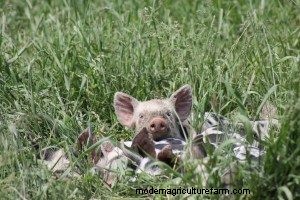
Verschillende varkensrassen hebben verschillende eigenschappen, waaronder verschillen in grootte, vleeskwaliteit en temperament.
Dit zijn dingen die u wilt onderzoeken bij het kiezen van uw biggen voordat u ze mee naar huis neemt.
We fokken traditionele varkensrassen (Gloucester Old Spot, American Guinea Hog, Tamworth) vanwege hun volgzame en vriendelijke karakter en uitstekende vleeskwaliteit.
Het Amerikaanse caviavarken is een veel kleiner varkensras en zal geen conventioneel karkasgewicht opleveren, maar vanwege hun gemakkelijke hanteerbaarheid en vlees van chef-kokkwaliteit is het een afweging die we bereid zijn te maken.
Varkensvlees Rhyne's eerste varkens waren eigenlijk een erfgoedras genaamd "grote zwarten" en "rode wobble", hij heeft ook enkele kruisingen en commerciële varkens grootgebracht.
200 jaar geleden kregen varkens niet het voer dat ze nu krijgen. Het waren dieren met weinig input, net als kippen, waar ze etensresten uit de keuken of tuin kregen, vrij rondliepen en herkauwden, enz.
Jarenlang waren varkens de "fail-safe". Als een oogst een jaar lang een slechte oogst had, hadden gezinnen altijd varkens om te verkopen om rond te komen.
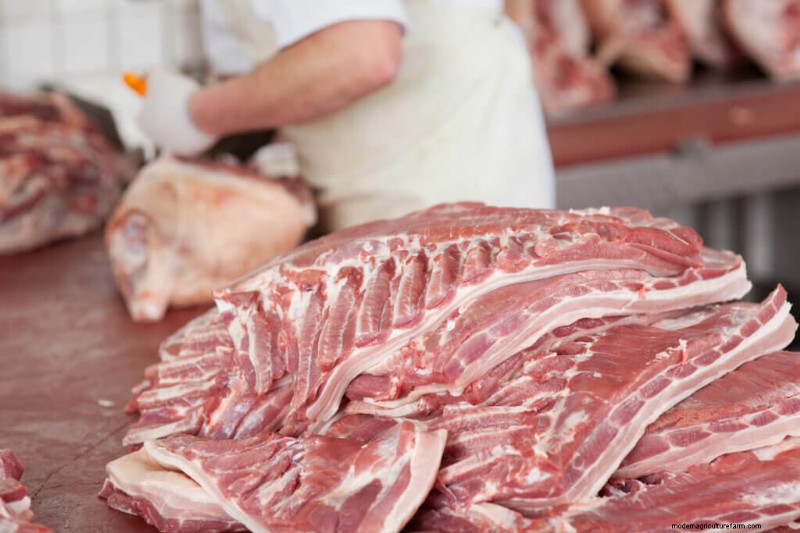
De meeste erfgoedvarkens worden geslacht als ze levend ongeveer 180-250 lbs wegen. Dit resulteert in een hangend gewicht (vlees en botten minus het hoofd, de voeten en organen) variërend van 160-225 lbs.
Hoeveel vlees je uiteindelijk in je vriezer krijgt, is volledig afhankelijk van het soort vlees dat je kiest tijdens de verwerking.
Het is belangrijk om te begrijpen dat varkens van traditionele rassen langzamer groeien dan commerciële varkens.
Gewoonlijk hebben erfgoedrassen ongeveer 8 maanden nodig om ongeveer 280 pond te bereiken. De reuzelvarkens hebben tot een jaar of anderhalf jaar nodig om het slachtgewicht te bereiken (dat soms, afhankelijk van het ras, niet zo zwaar zal zijn).
Maar commerciële varkens bereiken 280-300 pond in slechts 6 maanden. U kunt dus zien waarom commerciële varkens populairder zijn geworden bij grote boerderijen.
Download deze kaart van de Livestock Conservancy Organization voor meer exacte informatie over elk individueel ras .
Weet waarvoor je varkensvlees wilt fokken voordat je je ras kiest. Veel rassen zijn veel beter voor zaken als braadworst, worst, charcuertery, enz. terwijl andere rassen je hammen, karbonades en grote braadstukken geven.
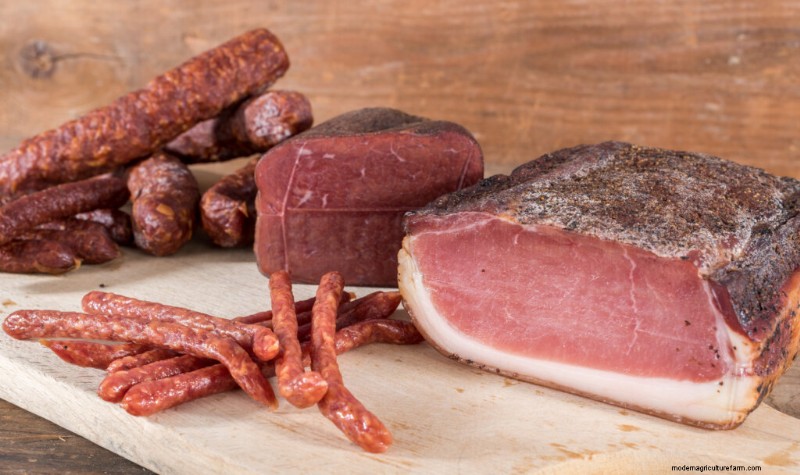
We hebben al menig varken geslacht op onze boerderij. Als je het eenmaal leert, is het niet zo moeilijk, maar de eerste keer kan een beetje intimiderend zijn.
Het hele proces duurt ongeveer 3 dagen. De eerste dag is het doden en ophangen, de tweede is het villen en in stukken snijden, de derde is meestal worstverwerking.
Een nadeel van jezelf afslachten is dat tenzij je weet hoe je spek en ham moet genezen je zult niet eindigen met die bezuinigingen (je hebt verse ham die echt goed is, maar niet zoals traditionele gezouten ham).
Het voordeel van zelf slachten is de kennis en de kostenbesparing. Traditioneel kost het laten slachten van een varken ergens tussen de € 150 en € 250, afhankelijk van de verwerking en uitharding.
Door uw eigen varkens groot te brengen, bepaalt u wat ze eten, wat zorgt voor een gezonder product voor uw gezin.
Ook is het grootbrengen van varkens erg leuk en ik kijk graag naar hun capriolen. Ik vind echter dat de smaak de beste reden is om varkensvlees te kweken. Als je het eenmaal hebt geprobeerd, wil je nooit meer varkensvlees uit de supermarkt.

Amy is een vrouw en moeder van 18 kinderen. Naast ouderschap en thuisonderwijs voor hun megafamilie, runnen ze ook een kleine familieboerderij, die ze liefkozend "Autumn Creek Ranch noemen. .” Ze houden van het werk van Joel Salatin (ik ook!) en hebben veel van wat ze doen door zijn voorbeeld gevormd.
Heeft u een vraag over het houden van varkens? U kunt Amy e-mailen op [email protected]
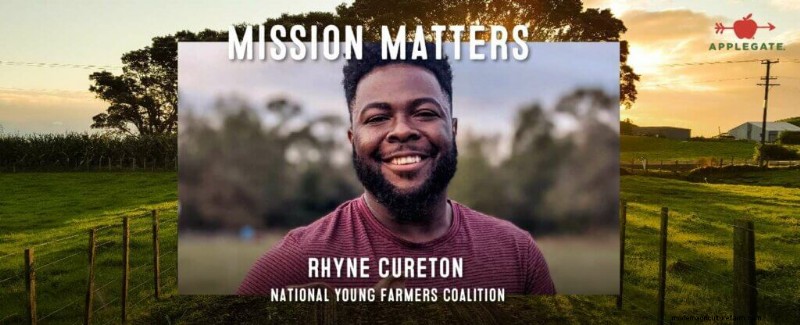
Luister zeker naar de podcast (vanaf minuut 41) om te horen over het werk van Pork Rhyne in derdewereldlanden via het bedrijf EATBETA – Evangelizing Africa Through Business Empowerement in a Transformation of Agriculture.
Melissa K. Norris: Hé, pioniers. Welkom bij aflevering nummer 331 van de Pioneering Today Podcast ... Vandaag gaan we het hebben over een van mijn favoriete onderwerpen. Ik heb het gevoel dat ze allemaal mijn favoriet zijn, maar dit staat absoluut bovenaan, en dat gaat over het fokken van varkens. We hebben het fokken van varkens al eerder behandeld in verschillende afleveringen van de podcast. We hebben het gehad over het Heritage American Guinea Hog-ras dat bekend staat ... ik gebruik aanhalingstekens, ook al kun je ze niet zien ... zoiets als, ook wel bekend als "het varken van de homesteader". Mijn ervaring, in de shownotities, we zullen daarnaar linken als je enkele van die eerdere afleveringen wilt bekijken, mijn ervaring daarmee.
In de aflevering van vandaag ben ik erg opgewonden, omdat we in varkens gaan duiken, maar we gaan het hebben over veel algemeen of vaak gezien advies als het gaat om het houden van varkens, met name over het voer, wat u uw varkens voert, weidebeheer en dergelijke die vaak onnauwkeurig zijn, of niet noodzakelijkerwijs het varken en de boer het beste dienen. In de aflevering van vandaag gaan we in op de gast van vandaag. Ik ben erg opgewonden. Je hoort, zodra we aan het interview beginnen, hoe ik ze heb ontmoet, een beetje achtergrondverhaal. Ik ga je waarschuwen dat, wanneer ik hem voorstel, je volume niet te hard moet staan. Het is maar voor de eerste kleine minuut. Je begrijpt waarom ik dat zeg als je daar aankomt. Het is allemaal erg leuk, en ik denk dat je er echt van zult genieten en van zijn enthousiasme over het onderwerp.
Voordat ik daar aankom, wordt de aflevering van vandaag gesponsord door ButcherBox, wat heel toepasselijk is, aangezien we het over vlees hebben. Als je nog niet zover bent op je homestead-reis, of als je geen lokale boer hebt waar je je vlees kunt kopen, dan maakt ButcherBox het gemakkelijk om hoogwaardig, humaan gekweekt vlees te krijgen dat je kunt vertrouwen. Ze leveren 100% grasgevoerd en met gras afgewerkt rundvlees, biologische scharrelkip en traditioneel gefokt varkensvlees, samen met in het wild gevangen vis, direct aan uw deur. We hebben eigenlijk al het bovenstaande geproefd. Het kwam altijd en was helemaal bevroren, zelfs als het helemaal aan het einde van de dag was, en helemaal aan het einde van de landelijke route die we volgen voor een bezorger. We hebben er geen gehad die we niet leuk vonden. Ik ben erg onder de indruk van de kwaliteit, de smaak, de manier waarop het kookt. Alles boven het bovenstaande, als het niet iets is dat je zelf kunt opvoeden.
Een van de geweldige dingen is dat er tot en met 20 januari een speciale actie gaande is omdat je een Pioneering Today Podcast-luisteraar bent. Het is de nieuwjaarsbundel. U kunt zeven pond meet gratis krijgen in uw allereerste box wanneer u zich aanmeldt als nieuwe klant bij ButcherBox. Ga naar ButcherBox.com/PioneeringToday om dat vast te houden. Dat is ButcherBox.com/PioneeringToday. Krijg je zeven pond vlees gratis in je eerste doos. Heel erg bedankt, ButcherBox, voor het sponsoren van de Pioneering Today Podcast.
Als je een nieuwe luisteraar van de podcast bent, welkom. Een lange tijd luisteraar, high five. Welkom terug mijn vriend. Mijn naam is Melissa K Norris. Ik ben een homesteader van de vijfde generatie en ik help elke maand duizenden mensen om te leren hoe ze een zelfgemaakt en handgemaakt leven kunnen leiden met behulp van eenvoudige, moderne homesteading, waar je ook bent. De gast van vandaag staat bekend als Pork Rhyne. Zijn echte naam is eigenlijk Rhyne Cureton. Ik geloof dat je het zo zegt. Hij staat bekend als een varkensvlees-evangelist in het hele land, en zelfs in het buitenland in Oost-Afrika, waar we het nog over gaan hebben. Ik vind het heel interessant en boeiend. Hij werkt als internationaal landbouwvoorlichter en expert op het gebied van vleesmarketing. Al meer dan vijf jaar wijdt Rhyne zijn leven aan het trainen en opleiden van ervaren en beginnende boeren, voornamelijk op het gebied van kleinschalige veehouderij, handel en marketing. We gaan het zeker hebben over het fokken van varkensvlees in een kleinere boerderijomgeving, dus ik ben heel erg opgewonden om hem op de podcast te verwelkomen en erover te praten.
Om links te krijgen naar enkele van de vorige afleveringen waar ik het over heb, en enkele dingen waar we het over zullen hebben, kun je dat allemaal downloaden op MelissaKNorris.com/331. Dat is alleen het nummer 331, want dit is aflevering 331. Nogmaals, MelissaKNorris.com/331. Laten we naar de aflevering van vandaag gaan.
Nou, ik ben super enthousiast over deze aflevering. Ik ga jullie allemaal waarschuwen. Het zal een hoge energie zijn, omdat ik maar heel weinig mensen ontmoet die de neiging hebben om het energieniveau te hebben dat ik heb. Zonder verder oponthoud, Pork Rhyne, welkom bij de Pioneering Today Podcast.
"Varkensvlees" Rhyne Cureton: Ik ben opgewonden. Ik ben opgewonden. Je hebt de verkeerde persoon hier gebracht.
Melissa K. Norris: Ik denk niet aan verkeerd. Ik denk goed na. Ik hield van je energie bij HOA, dus ik was echt blij. We waren een beetje aan het kletsen voordat we begonnen met opnemen, jongens, en ik stuurde hem eigenlijk een uitnodiging voor de podcast die hem geen kans gaf om te buigen of nee te zeggen. Ik zei eigenlijk:"Hé, op welke datum en tijd wil je uitgaan?" Ik ben echt blij dat hij mijn sterke gewapende uitnodiging heeft aangenomen en geaccepteerd. Ik ben erg opgewonden. Ik heb het gevoel dat we veel gaan behandelen in deze aflevering, dus we gaan er gewoon meteen in duiken.
Een van de dingen, toen we aan het kletsen waren, was dat echt [onhoorbaar 00:06:06]. U zei dat u veel online aangeboden ziet. Ik ga ervan uit, omdat ik graag het beste van iedereen aanneem, dat veel van dit spul met goede bedoelingen wordt aangeboden, maar je ziet veel dingen als het gaat om het online fokken van varkens, of vaak, zou ik moeten zeggen , dat problemen veroorzaakt of problematisch kan zijn. Ik zou graag willen dat je daar wat meer in duikt.
"Varkensvlees" Rhyne Cureton: O ja. O ja. Laten we hier op ingaan. Achtergrondinformatie over mij. Ik boerde vroeger. Zal teruggaan naar de landbouw. Gewerkt met de National Pork Board in Pork Checkoff. Opgegroeide erfgoedrassen toen ik landbouwde. Zal teruggaan naar erfgoedrassen. Ik heb de afgelopen vijf jaar mensen geleerd hoe ze varkens moeten fokken, zowel in het land als in het buitenland. Ik gebruik die ervaring terwijl ik hierover ga praten.
Een van de dingen die me zijn opgevallen bij mensen die in de varkenshouderij beginnen en die in hun hele leven nog nooit varkens hebben gehouden, waarschijnlijk niet eens uit een agrarische achtergrond, is dat er veel problematische kwesties in termen van voer, in termen van landpraktijken, in termen van dierenwelzijn, en ik durf te zeggen legalisme, wanneer we in homesteading-groepen komen, groepen die alternatief zijn voor de conventionele normen en modellen met de varkensvleesindustrie. Ik heb veel verkeerde informatie gezien over hoeveel je je varken moet voeren.
Oh man. Melissa, er is zoveel tegenstrijdige informatie. Het zou iemand gek moeten maken, eerlijk gezegd. Ik voel mee met mensen die beginnen met het fokken van varkens en geen idee hebben waar ze moeten beginnen, of ze gaan naar een blogpost en gaan dan naar een paar YouTube-video's. Ze krijgen totaal andere informatie. Er is niet echt enige consistentie of continuïteit. De meeste mensen zoeken naar een formule, zoals:"Wat is een formule die ik kan gebruiken en waarmee ik succesvol kan zijn?" De enige mythe die ik wil ontkrachten, een van de grootste mythen die ik ooit heb gezien, onzin, is dat hier geen formule voor is.
Melissa K. Norris: Amen. Amen.
"Varkensvlees" Rhyne Cureton: Er is absoluut geen formule. Als je nu in de commerciële conventionele landbouw stapt, is er eigenlijk een formule. Als je die volgt, komt het helemaal goed. Voor de erfgoedrassen, voor mensen die buiten varkens houden, of in de wei of in schuren, is het heel anders. Er is niet die consistentie omdat, A, je hebt de elementen die bepalen hoeveel een varken zal eten. Als het bijvoorbeeld warmer is, houden varkens er niet van om te eten als ze warm zijn. Dat doen ze gewoon niet. Ze doen niet een beetje. Dan neemt hun vermogen om spiermassa en vet te krijgen af omdat ze niet zoveel eten. Rechts? Als het koud is, eten ze veel meer, omdat ze graan proberen te gebruiken, of wat je ze ook voert, als een manier om warmte op te wekken zodat ze warm blijven. Er is niet echt enige consistentie omdat we geen varkens fokken in omgevingen met laboratoriumratten. Dat zijn we gewoon niet.
Een ding dat ik echt promoot, is het hebben van een boerenoog. Daarmee bedoel ik niet alleen een dier voeren, water en onderdak geven. Niet alleen die dingen, maar alle inhoud daar tussenin. Rechts? Wat dat echt vereist, zijn observatievaardigheden. Je gaat fouten maken. Nou, niet jij, Melissa, maar het publiek. [overspraak 00:09:44]
Melissa K. Norris: Oh nee. Ik maak veel fouten, maar bedankt daarvoor.
"Varkensvlees" Rhyne Cureton: Proberen je niet onder de bus te gooien... Als je boer bent en je gaat aan de slag, dan ga je veel fouten maken, qua voer, qua huisvesting, qua dierenwelzijn, en dat is prima. Er is veel tegenstrijdige informatie en veel mensen die video's of blogs maken die niet noodzakelijkerwijs de achtergrond hebben die ik heb, of de achtergrond die een conventionele varkenshouder zou hebben. Veel mensen leren van mensen die net beginnen. Er zijn veel mensen die leren hoe ze varkens moeten fokken van mensen die een jaar of korter varkens houden. Rechts? De mensen die al meerdere jaren, vijf jaar, 10 jaar, 20 jaar varkens fokken, en zelfs buitenshuis, zijn niet online, omdat ze het te druk hebben met het fokken van varkens. Dat kan in veel gevallen problematisch zijn.
Een ding dat ik wil zeggen, is dat je genade hebt met jezelf terwijl je begint en dingen uitzoekt. Begrijp gewoon dat er geen formule is, en dat die formule verandert met het ras, met het specifieke type varkens dat je krijgt. Zelfs binnen een ras zijn er verschillende variaties in maten. Melissa, jij fokt Amerikaanse cavia's. Er rijdt een grote [onhoorbare 00:11:01] en er zijn er die heel klein zijn gemaakt. Het verschil in uitgroei kan heel drastisch zijn tussen die twee verschillende soorten binnen dat ene ras. Er zijn veel nuances met fokvarkens.
Een deel van mij dat nu uiteindelijk met Pork Rhyne TV begint, is dat ik mensen kan laten begrijpen dat je succesvol kunt zijn in het fokken van varkens binnen jouw specifieke context. Het belangrijkste is om flexibel te zijn, constructieve kritiek te kunnen verdragen en observatievaardigheden te hebben en die observatievaardigheden met betere praktijken te gebruiken. Ik heb veel mensen gezien die helaas in wetticisme vervallen. Ze zeggen:"Wel, deze persoon fokt varkens op deze manier, dus als je geen varkens fokt op deze manier, dan ben je geen goede boer." Ik hoor dat vaak. Ik hoor veel mensen zeggen:"Nou, als je je varkens niet in de wei houdt, dan ben je geen goede boer." Nou, ik geloof dat zowat iedereen varkens kan fokken, en ik denk dat ik hier wat haatmail voor kan krijgen. Ik geloof niet dat weideproductie voor varkens de enige manier is. Toch?
Melissa K. Norris: Juist.
"Varkensvlees" Rhyne Cureton: Ik ben in Afrika geweest. Ze hebben prairies. Ze hebben savannes. Ze hebben geen weiland. Als ze weiland hebben, zetten ze er geen varkens op. Ze zetten koeien. Ze zetten geiten en ze zetten daar schapen op. Varkens zijn het laatste wat ze in de wei gaan zetten. Dat heeft absoluut geen zin. Ze hebben ook tweebenige roofdieren. Rechts? Ze hebben niet alleen de vierpotige wilde dieren. Ze hebben tweebenige roofdieren, oftewel mensen, die daadwerkelijk hun varkens komen stelen. Er is geen elektriciteitsnet als er elke dag stroomonderbrekingen zijn, of een paar keer per dag. Rechts? Ik kijk graag naar, wat is de context? Wat zijn uw beperkte middelen? Wat heb je? Wat is jouw ervaring? Hoeveel tijd heb je hiervoor?
Als ik dan met boeren werk, help ik ze gewoon om hun eigen plan te maken binnen hun gegeven beperkingen, hun gegeven tijdsmanagement, hun bepaalde levensstijl en de manier waarop nog steeds goed dierenwelzijn mogelijk is. Er zijn sommige mensen die erg legalistisch zijn, binnen onze specifieke sector van homesteading en landbouw, die uiteindelijk commerciële boerderijen echt bashen. Dan is het probleem dat ik zie wanneer ik naar deze homesteading-boerderijen ga. I see animals in more deplorable situations than when I see when I go into a commercial hog situation, or even when I see when I go to East Africa. Explain that to me. How can one person be bashing and sense some, yet not have proper animal welfare? That makes absolutely no sense, but this is something that I see a lot in common with people who want to have a formula for how they be successful, or want to be in legalism on there's only one way of doing something right. I truly don't believe that. I think there are multiple ways of having healthy hogs, and even a healthy family with those hogs.
Melissa K Norris: Ja. I completely agree with you on so many things, especially with the context in looking with where you at and working within the resources, and also understanding climate, as well as workload. Until very recently, actually, I worked a day job where I was commuting. I was a pharmacy tech and was commuting 18 miles one way. My husband still works off of our homestead and farm, so he still has a day job. For us, we do have our pigs on pasture, but we don't rotate them. They're not on fresh grass every day, simply because when you leave at 5:00 AM in the morning, and it's dark, and you're not getting home until sometimes 6:00 at night, if not later, there's only so many hours in the day. I think, just like you said, that that legalistic part ... Yes, no matter what method you choose to raise your pigs, you're going to want to make sure that you are raising them as ethically and as humanely as possible, but there's more than one way to do that.
I'm really happy that you're talking about that, and also looking at your climate, because, from our experience, the American Guinea Hogs that we had, it overall was a very pleasant experience that I have. Were They Worth It?: a different episode you guys can all go and listen to on that in drawing the difference between raising the Hereford versus the American Guinea Hogs. You really need to dig into your climate with the different breeds, as well as expectations.
I wanted to circle back to one of the things, and that is feed. Feed, not only how much, as you said, and definitely your climate, and the time of year, and so many things we're going to determine. The best thing is looking at the animal. Does it look healthy? Does it look underweight? Is it looking too fat, and [inaudible 00:15:45] ... but types of feed, because, as you know, that is also controversial. Who knew homesteading could be so controversial? I swear, every aspect of homesteading I talk about, there's controversy somewhere or another. I'd love to address that, because I know this is a thing where some people are like, "Well, just go. Go to the bakery and get day old bread that they're getting rid of." Then you've got your purists. Rechts? There's all these things. Let's talk about them. Why is that a good idea? Why is that not a good idea? All the things. Let's dive into feeding pigs.
"Pork" Rhyne Cureton: Oh man. You mentioned earlier of what does a healthy a pig look like? I think part of the issue is a lot of people who are starting raising pigs doesn't know what a healthy pig looks like.
Melissa K Norris: Yeah.
"Pork" Rhyne Cureton: Or how a healthy pig behaves, so that's part of the reason why I'd say, before you get your pigs, spend some time volunteering on a local farm that has the practices that you want to have, if possible. That's not for everybody. Not everyone has the time or energy. Even if it's just like, "You know what? I'm just going to spend a weekend once a month going to a farm. They might be a couple of miles away, several miles away, but I want to learn how they're doing things and get acclimated," because when you're starting out with no understanding of a strong foundation of what a good animal looks like, of what good proper feed management looks like, then you're just shooting in the dark hoping that you hit something. Sometimes that might be at the detriment of your hogs. I've heard plenty of stories. Pigs die. Laat me je iets vertellen. It's hard to kill pigs. You have to really try hard to kill pigs, but I've heard plenty of stories of homesteaders that had mismanaged their pigs so poorly that they end up passing away.
Melissa K Norris: Wow.
"Pork" Rhyne Cureton: That's extraordinarily unfortunate. That's why I say get under somebody who knows what they're talking about, not just these people on YouTube or on the blog posts, but someone who's got five years of experience, even three years of experience raising pigs, and can give you a little bit of advice and guidance. If we're starting to talk about feed, one thing, at the HOA conference, I did a whole thing about alternative feed, because I know that's what homesteaders love to talk about. They love to talk about how they're getting alternative this and alternative that, and saving money here and there. Oftentimes I've seen pigs who are emaciated, or pigs who are obese, pigs who have carcass qualities that aren't what the homesteader intended them to have. Right?
Melissa K Norris: Mm-hmm (affirmative).
"Pork" Rhyne Cureton: If you're expecting the meaty hog but you're feeding it nothing but carbohydrates, when it's time to process it, all you're getting is a really fat, obese pig. You're getting more lard than you probably know what to do with. Now, with homesteaders it's not as much of a problem, because a lot of homesteaders like to use lard.
Melissa K Norris: Amen.
"Pork" Rhyne Cureton: Amen. Thank the lard. Praise the lard.
Melissa K Norris: Ja. Yep.
"Pork" Rhyne Cureton: Praise the lard. Praise the lard. Hallelujah ... A lot of times it's like, "Oh, but I wanted more weeks. Oh, but my bacon, it's 90% fat and 2% actual muscle meat. Why is that?" I think the biggest thing is understanding what is feed? What are the components of feed? At the conference, I talked about how very simply, and I teach this in East Africa where I'm not speaking their language. I have to have a translator to do that, so I have to speak very simply. What I normally will say is feed is made out of carbohydrates. Examples of carbohydrates using feed, would be things like corn. Rechts? Energy source. Rechts? Think of carbs as energy sources. Then you have your protein source. Oftentimes a conventional feed will use soybeans as a protein source. Rechts? Then you're thinking about fiber, minerals, other different aspects about feed that really go a long way in terms of having a healthy quality hog.
I can say, "Oh, well, just feed 16% protein, for protein feed, that's already been milled, and feed that to your pigs." Well, that's not completely accurate because, for American Guinea Hogs, they're so obesity prone that they really need to be on an extraordinarily limited grain diet. Rechts? More opportunity for forage, so don't feed them a whole bunch of bread if you have lardy based pigs, unless you want a lot of fat and not a lot of meat. If that's what you want, perfect. Prima. You're doing a great job. If you're wanting more meat on your hog, but you're raising heritage, more lardier breeds, then you want to be really consistent and conscious about how much carbohydrates they're eating.
Let's say you have a meatier pig, like I would at Jason at [inaudible 00:20:44]. We had butchered a hog, and I was examining the meat quality. We talked about it, because he was really disappointed that he didn't get a lot of meat. I asked him, "Pick nine million questions." At the end of it, it came out to the fact that, potentially, his pigs were being fed organic 16% crude protein feed all the way throughout their entire life. Rechts? Oftentimes, when we start practicing more proficient swine husbandry, around two months to three months before the pig is going to be slaughtered, we actually reduce the amount of crude protein down to 14%. Maybe even 12%, depending on the breed. The reason why we will do that is because we want to reduce the amount of protein and increase the amount of carbohydrates, because if you increase the amount of carbohydrates, what that means is you get more fat. They'll going to store all that energy into fat. Rechts? If you think about people who eat meat, versus people who eat nothing but bread. One of these is going to get fatter than the other. Right?
Melissa K Norris: Mm-hmm (affirmative).
"Pork" Rhyne Cureton: That's one way of really looking at it is from that aspect, but it depends on your breed. For people who are raising, again, larder based breeds, you've got to be really mindful about how much to feed your pig grain, or anything that's floured, or baked goods. That, too. Otherwise, you'll get a lardy pig and not a lot of meat. If you have more muscular pigs like the Herberts ... I dare even say Gloucestershire Old Spots, Tamworths, Durocs, then that's not going to be a huge concern. You actually want to make sure that your pigs do gain fat before processing, so you want to actually increase your carbohydrate load before their processing date by two months. I would have enough fat cap on them to where you get flavorful, delicious pork, because fat is where the flavor is at.
Melissa K Norris: That's why we like bacon.
"Pork" Rhyne Cureton: Bacon, yes.
Melissa K Norris: Ja. That's fascinating. Speaking of the timing and the climate, as you were talking, with our Herefords, when we raise and butcher them we typically butcher in October, which means from August on we've got tons of apples around here. We actually make up an apple mash that we feed them in order to supplement the organic food that we're buying for them, and because we're butchering them in October, we've got apples all the way out to finish them. They're not a lardier breed, like you said. As you were talking, I was going back over it. With the American Guinea Hogs, we actually kind of reversed that, because we butchered them the end of January. The last two months before butcher date, we didn't have any apples left, because obviously by then we'd went through all that we had, just because of the time of year. Their carbohydrates actually got reduced the last two months before butcher. Of course, I still got massive amounts of lard.
Talking about feed and the carbohydrates, as well as their protein sources. As I said, we like to supplement with apples when we can, which is a fruit. There's fiber in there, but obviously [inaudible 00:23:58] vegetables from the garden, and all of that. When you're looking at specific protein sources other than soy, and I personally try to avoid soy. With every study under the sun, you're going to find a study that can kind of back you up one way or the other, it seems. I personally try to avoid soy, especially conventional soy, because of GMOs.
"Pork" Rhyne Cureton: Wow, you sound like you're from the Midwest. GMOs.
Melissa K Norris: Rechts? I can adapt accents here. When you're looking at protein sources, if you're trying to go the route of producing more of the pigs' feed on your homestead, what would be some other protein sources that one could look at?
"Pork" Rhyne Cureton: Good question. Before I even talk about, I have to say that the source of protein, if you're buying feed, is generally the most expensive ingredient in your feed bill. A, that's why when you reduce your crude protein from 16 to 14, you note that there's a significant difference in cost. It is important to figure out, what are some other ways of finding something other than soybeans? Cool fun fact about soybeans. The reason why it's so popularly used globally has nothing to do other than the fact that they were able to market the soybeans very well on the global level. That's all it had to do. There are alternatives such as rapeseed, pearl millet, the grain variety, sunflower seeds, and even field peas, that equival, if not exceed, soybeans in terms of crude protein. I think field peas are a really good way of either having food plots up for your pigs and allowing that being a source of protein. The trade off would be that you have to be really mindful of timing when your pigs enter into that food plot. I know some farmers will actually grow several acres of their local variety of field peas.
Some work better in different climates. In the Georgia, North Carolina area, iron clay peas work very well. Iron clay peas probably wouldn't work well where you're at, Melissa. They'll bale those fresh peas. They'll bale it all, and they'll make it into a silage, or something like that, that they'll feed throughout the year. That's one way that people get around that. If you're not at an efficient economy of scale, meaning that you don't have a lot of acres, you don't have a lot of machinery, it can be really challenging.
I've got one friend. He'd go to Chipotle, and he gets beans from Chipotle. That's what he does, is he gets the beans from Chipotle. Actually, he gets the beans, the chips, all the things from Chipotle, and he feeds that to his hogs. He also raised American Guinea Hogs. He never really spent a dime on actual feed. Do I recommend that? I only recommend that if it is not post-consumer. I repeat, not post-consumer. I do not recommend post-consumer restaurant scraps. What I mean by that is someone ate it, took a bite into it, threw it in the trash, and then that restaurant collected that food scraps and then gave it to the farmer. That farmer gave it to the pigs. That's a good way of spreading diseases. I don't recommend that.
Restaurants will have scraps or leftover food that didn't go to the consumer, because it's still sitting on the bar. Then what they'll do is, if you're working with a farmer, the farmer will say, "Hey, just put it in a bucket, or put it in a trash container. I'll provide the trash container for you. You just dump it out. Just make sure that there's no pork in it." Do not feed your pigs pork.
Melissa K Norris: Ja. Yes, for the love.
"Pork" Rhyne Cureton: They might give them $20 for a couple of trash cans, or something like that. Something people, they're like, "Don't even pay us. We're just glad that this waste is going towards something good and meaningful." That's a way that you can kind of do it. If you're trying to grow your own grain, your own protein source, it's going to be really challenging. That's why a lot of people just go to buy bagged feed anyway. Again, bag feed is more expensive, unless you have the acreage, or, I daresay, unless you work with farmers who have the acreage. You don't have to do everything on your own. I talk to plenty of farmers who don't have the same amount acreage that they would like to have, but they're still getting field peas, sunflower seeds, pearl millet, rapeseed, from other farmers who are nearby, and just partnering with them. That way it's more of a cooperative effort, rather than, "I have to figure this out all by myself and all on my own."
Melissa K Norris: Ja. That's why, really, with our climate and the amount of acreage that we do have, we have purchased supplemental organic pig feed mix. We actually have a local granary mill that's about an hour away from us. That feels good because they try to source from as many local farmers as they can, and it is certified organic, which is important to me. I know that's not important to everyone, and that doesn't mean that everybody has to go that route. We do pay more for that feed. Again, that's a personal choice.
I love the suggestion of Chipotle, and the reason I love that is because they actually have a non-GMO stance, and have for a really long time. As far as looking at getting food sources outside of from a farmer, but a restaurant, even though it is a chain, that's probably one of the best ones that you could pick. I love that you gave that suggestion.
"Pork" Rhyne Cureton: Oh geweldig. Also, a pro tip. If you're using spent grain, just understand that 80% of spent grain is actually water. You're not getting the nutritional value out it. Spent grain, if it was dried, would have 26% crude protein. No, actually, I take that back. 29% crude protein. If it's wet, which is what people mostly get spent grain, it's only 7.7% crude protein, so misconceptions with that. Also, spent grain gets moldy very quick. I don't recommend spent grain as a primary feed source. I recommend it as an add on to an already complete diet [crosstalk 00:30:46]
Melissa K Norris: Wacht. I don't even know that terminology. What does spent grain mean?
"Pork" Rhyne Cureton: You think of brewer's grain.
Melissa K Norris: Oh, okay.
"Pork" Rhyne Cureton: Brewer's grain.
Melissa K Norris: Oké. I had never even thought of going that route, but I'm glad that you made that distinction for us. I'm learning all kinds of new things. Ik hou hiervan. We might just have to have a part two and have you back on. See, I think that-
"Pork" Rhyne Cureton: Ja. Yes.
Melissa K Norris: Yeah, because I've got so many more things that I want to ask, but I want to try to keep this somewhat concise. My listeners know conciseness is really not a skillset that I have developed, though I am working on it. Going back to a little bit of the breeds, because I think that's where we get enamored with heritage breeds. Ik snap het. I love heritous way. I grow an all heirloom seed garden. I love heritage, and I love being able to protect them. There's also a reason that hybrids, both in breeding programs, as well as garden seeds, have been developed. Can you talk a little bit to picking heritage versus other breeds, and then within heritage breeds? I know this could be an entire complete episode all on its own, getting into this. Within the heritage breeds, certain things to consider when you are picking a heritage breed, if that's the route you choose to go.
"Pork" Rhyne Cureton: Ik hou ervan. Yeah, let's get into that. With heritage breed pigs, some background on me, my first pigs were heritage breed. They were English Large Blacks. There's something about those Large Blacks. They're the black pigs with the super floppy ears. They look extraordinarily adorable. You can't see their eyes because their ears are covering it. Then Red Wattle. Then I've raised crosses, some of them heritage variety, the Hampshire and Duroc, as well as commercial Yorkshire. I'm grateful that I've had those different experiences. I've even bred, both purebred, as well as hybrids.
One thing that I'll say with heritage is that there's a reason why they're heritage. They do extraordinarily well in low input situations. What I mean by that is 100 years ago, 200 years ago, 300 years ago, these pigs were not being fed a strict grain diet. I'll repeat that one more time. They were not pampered. They were not pampered pigs that got fed a strict grain diet. They just weren't. They were getting fed any old kind of thing, from house scraps, slaughter waste. Then, once fields were harvested, they'll send the pigs out to clean up the fields. Rechts? Pigs were low input animals, just like chickens. That allowed for a lot of people to be able to have a meat source that was low input, meaning that that was saving them money. In fact, pigs used to be able to ... We can't say this so much today, but they used to be able to really be a life saver for a lot of families when crops failed that year. At least they had pigs to pay off any bills, their mortgage. Whatever it might've been.
One of the issues that we have today is that we have switched more to a commercial hog. Part of the reason of that is because somewhere around the, I believe, 40s, 50s, or 60s, somewhere in between there, there was a crisis on heart disease. People were trying to out what's causing heart disease. It came down to two things: sugar related products, and fat related products, including fat industries. Unfortunately, there was some falsified information, and sugar ended up winning. Fat ended up being the blame for heart disease. What ended up happening with that was ... That's why you have yogurt that's low fat. It literally says low fat, but like 12 grams of sugar in a cup. People don't understand that sugar, when not utilized properly, converts to what? Fat.
Melissa K Norris: Yes, and insulin resistance issues, and so many different things.
"Pork" Rhyne Cureton: Keep preaching, Melissa. Keep preaching. That's part of the reason why a lot of these animals went out of favor. They also went out of favor because, around the Industrial Revolution in this country, we realized that we can produce synthetic oils, cheaper vegetable oils, as a way of machinery. We were using whale blubber to oil trains. Now we're using more synthetic oils to be able to use machinery. That's another reason why pigs also went out of favor. Also, these pigs grow very slow. In terms of homesteaders, if you're getting heritage breed pigs, they will grow slower than your commercial pigs. Usually commercial hogs are ready at around six months, and they weigh somewhere between 280 pounds to 300 pounds. Usually around 280 at six months. Those are for your commercial hogs. Now, when you get a heritage breed, you do have some variation. Your Herefords ... What other breeds are there other than Herefords? Your Tamworths. Other more meatier breeds. Usually they're at 680. Sorry, 280, if not 300 by eight months. Rechts?
Melissa K Norris: Mm-hmm (affirmative). Yeah.
"Pork" Rhyne Cureton: Usually I'll say grow them out for an additional two months to get more back fat on them. Then you have your lard pig like your American Guinea Hogs. That can take a year to a year and a half, depending on the particular type of American Guinea Hog. English Large Blacks can take 10 years. Sorry, 10 months, to a year, a year and a half, to reach around 260. Right? There are a lot of different variations with the breeds. I highly recommend, if you want more information on the comparisons, just look up heritage hog breed comparisons chart. You should be able to find that at the LivestockConservancy.com. Sorry, .org. That'll give you way more information than you probably want to know on each individual breed from that standpoint.
Another thing to consider is, with heritage breeds, the medium breeds do very well with retail cuts. However, that's where they shine, because they provide more muscle mass. Dat is geweldig. With your lard based pigs, like your Mulefoot, your English Large Black, your Kunekunes, your American Guinea Hogs, they weren't made for, necessarily, meat production. They're made really more for fat production, with fat actual more valuable than the pork itself. They really shine in sausages and ground pork. They shine very well in charcuterie. Part of the reason why a lot of people who are raising lard based pigs are having issues with marketing their pigs is because they're marketing as if they're retail hogs, and they're not. They're absolutely not. They need to be marketed and treated a lot differently.
Again, fat is where the flavor is at. When you're doing bratwurst, no better bratwurst than a lard pig bratwurst. That's the best bratwurst you'll ever have. Best sausage you will ever have. Best charcuterie you're going to ever have compared to your more leaner breeds, even on the heritage side. If you're raising these heritage breeds, especially the large ones, start thinking outside of the box from retail cuts, because if you try to make pork chops out of an American Guinea Hog, your pork chops are going to be small. Your-
Melissa K Norris: You got sent lots of fat.
"Pork" Rhyne Cureton: A lot of fat. [inaudible 00:38:51] going to be extremely tiny. You can probably put a pencil through that. Think about it from the standpoint of I can sell these pigs, wholes and halves. I can turn them into charcuterie. I can turn them into ground pork and sausage, and maybe keep the bacon, depending, and hams. Hams, if you're going to use ham charcuterie as well. They don't shine well with pork chops. They don't shine very well with leg roasts, or Boston butts, or sometimes even bacon, or pork chops. They don't shine well doing those things, so stick to the shrimp of the pigs.
When I used to work for the Livestock Conservancy, I did change some of the utilization descriptions for the breeds. If you go on their website, LivestockConservancy.org, and look at the breed profiles, on the side you should be able to see the utilizations for those breeds. They should be up to date, because I did update them before I resigned from there. Those are my thoughts on that.
Melissa K Norris: Oké. Geweldig. I love that, because the American Guinea Hog was the best bacon we've ever had, bar none. The ham was fatty, but when I cooked it in the slow cooker, and then shredded it. Oh mijn god. It was amazing, but it's not like a spiral cut, when you think of spiral cut hams. That is not what you were getting. I'm with you there, definitely. If you we raise the American Guinea Hogs again, I probably will just raise them for the bacon, and the sausage, and a couple of the ham cuts. We won't even bother with the pork chops. I have to say, the pork chops were delicious because of the fat, and quite moist, but yet you're getting such little meat per pork chop cut. I almost have to cook six for our family of four just to barely get enough meat for everybody. I'm really glad that you brought those points up. It's kind of like, do we get a couple of American Guinea Hogs just for the bacon and sausage, and then raise the Herefords? Ik weet het niet. We'll see what we end up doing.
Some amazing resources in today's blog post that accompanies this episode. We will provide all of the links and different things that Rhyne has been so gracious to point us in the direction of. One of the things you had mentioned that I wanted to talk about and just, myself, learn more about, is your work in Uganda with raising pork. Can you tell us a little bit more about that? I find that fascinating.
"Pork" Rhyne Cureton: Ja. Yeah, definitely ... I lost my train of thought.
Melissa K Norris: It happens.
"Pork" Rhyne Cureton: I go overseas to East Africa, Uganda, as well as Tanzania, or Tanzania if you've got a country accent. I teach people, basically, in very simple manners, how to raise pigs within their context. I'm really blessed by that experience, because it allowed for me to really look at farming more contextually ... I made a rookie mistake. I remember my first year going. I go into an organization called EATBETA. It's E-A-T-B-E-T-A. It stands for evangelizing Africa through business empowerment and the transformation of agriculture. We're not simply about giving money to people. We're about how do we train and educate people on best practices with their business and with their farm.
One slogan that I use when I go over there is farming is business. Farming is business. I don't care if you're in it from subsistence living, or if you're trying to make money off of it. It's always a business, because you're having inputs, and there are outputs. Rechts? Usually that requires some type of economic or capital to be able to make that thrive. When I go over there, I'm working within their context. They don't say soybeans. They say soya. They don't say corn. They say maize bran. They're having limited ingredients and limited resources. They're using different even feed additives like sunflower seed cake, and fish meal, and all these other things. Being able to understand that not all of them are at a place where they can raise healthy pigs, it's really important. It's even sad sometimes when I have to recommend that they not raise pigs, because they're not at that scale.
I daresay, even to your audience, you might not be at a scale where it's economically viable for you to raise pigs. I want to let you know there is no shame in that. Absolutely no shame in that. Stick to chickens. Grow that chicken operation out a little bit more, whether it's egg production or meat birds. I recommend meat birds, and scale up from there. That's what a lot of people have done to really be successful with raising pigs. They start out small. They start out with chickens, and then they build up to pigs, and then they'll build up to cattle, or maybe the goats and sheep. That's probably a really good model for East Africa is showing people that you can scale up your farming operation. You have to do it incrementally. A lot of people who are philanthropists will just donate tractors to East Africa. Rechts? These people don't know how to use a tractor. Most of them don't. When something breaks down, they can't fix it.
When my team goes down there, we're not teaching how to use a tractor. We're teaching, how do you hand plow? How do we get you from a hand plow, or hand hoe, to a hand plow, where you're actually tilling the Earth through a hand mechanized plow? We're doing funding for that, and we're giving those out. It's appropriate technology, appropriate training and education, rather than we're just going to give money, rather than we're just going to fix all your problems. No. We're going to teach, how do you run a business? When I go over there, I teach farming is a business, and I teach people that animal welfare, because there are a lot of issues with animal welfare in countries that would be deemed third world or developing. People over there don't treat pigs like pets. They treat pigs like stupid dirty animals.
Part of what I do is I teach animal welfare is not necessarily the primary goal. The primary goal is economics. The primary goal is making money. Well, if I know that their real issue is they want to make money, then I equate proper animal welfare with higher profitability. For example, if you are putting your pig on a more standardized feed ration, your pigs grow out faster, meaning you get your money quicker. Very simple and easy. Rechts? If I talk about how reducing your herd if your herd is unmanageable, you have too many pigs, and you can't afford to have too many pigs, by reducing your herd and just sticking to a few and feeding those well, it increases your reputation. Now, you're having pigs that are actually at weight. People are getting that pork, and they're getting the quality pork that they're wanting, rather than emaciated pigs. Rechts? That increases reputation. That means comeback customers.
When you're dealing with breeding, thinking about when you're really treating your sow with respect. Not beating it. When you're really giving your sow enough water, enough feed rationing, then that allows for you to have healthier piglets. That allows for your piglets to be weaned to survival, and then that means more profit per pig. Rechts? Everything really can boil down to economics when I go over there, and that's allowed for me to translate that back to the states, and really show people that every decision that you make as a farmer has an economic impact. It will always have an economic impact, whether big or great, or small or great, small or great.
That allows for a lot of people to see that their decision to switch feeds, that's an economic decision. Can you afford to do that? If not, that's okay. There's no shame. Or I want to do this opportunity with sausage, or opportunity with a live event. Oké, gaaf. What's the economic impact on your farm, and how much money will it cost? That really gets people thinking about, "How do I save money, or how do I reduce my costs, or how do I become more profitable in the enterprise I already have?"
Melissa K Norris: Wauw. I love all of that. That, again, is an entire 'nother episode. We could probably talk for hours and hours and not get through everything, but this was great. Ik heb er echt van genoten. Would love to have you come back on. For those who are wanting to learn more about you, learn from you, check out more about your farm and the work that you're doing, what's the best place for people to connect with you?
"Pork" Rhyne Cureton: People can connect with me on ... People have been begging me to start a YouTube channel, and I resisted it for, I think, about a year. I recently have made a channel, and I'll be posting videos on it by the end of this week. Whenever you have this recording out, I will have already posted videos. That's the best way.
Melissa K Norris: Okay.
"Pork" Rhyne Cureton: I am considering leaving Instagram, so I won't be on Instagram. Then, for emails, you can email me at Rhyne, R-H-Y-N-E, @PorkRhyne, P-O-R-K, R-H-Y-N-E, .com.
Melissa K Norris: Geweldig. Now, I know Rhyne is your first name, but my great grandmother's last name was Rhyne. I just had to throw that fun little tidbit out there. Spelled exactly like yours.
"Pork" Rhyne Cureton: Koel. We're long lost cousins. That's all it is.
Melissa K Norris: Yeah, I agree. This has been a blast. I can't wait to learn more from you, and just be able to share that knowledge to get more people raising more of their own food, and taking control of their food source. Thank you so much for coming on today.
"Pork" Rhyne Cureton: Amen. Amen. Glad to be here, and I appreciate what you're doing with your podcast and your YouTube channel. You're one of the few folks in that space where I don't cringe when I watch a video, so just thank you for the good work that you're doing, and the honesty that you have behind it. It really means a lot to me.
Melissa K Norris: AW, bedankt. I hope you had as much fun as I did with today's episode and picked up some tips if you are planning on raising your own pork, or maybe you already have pork, but you were able to glean some tips and some ideas on where you could get some extra feed without a bunch of extra expense, which I know that always gets me super excited when it comes to our homestead endeavors. Well, this episode was all about raising pork, or mainly about raising pork.
Next week, I have another really fun episode for you where we will be having a guest, and we will be talking about homesteading, but, in particular, gardening. Especially if you have young children, or children at home, how to get them incorporated, but also still how to have a garden and try to stay sane. If you have infants, or toddlers, or really young children, it can often be hard trying to juggle it all. We are going to dive into this. I had so much fun doing these episodes. I know you're going to enjoy them just as much as I do. That is coming up for you next week. Blessings and mason jars for now.
Scroll back to top
Enter your name and email address below and I'll send you periodic updates about the podcast.
aangedreven door